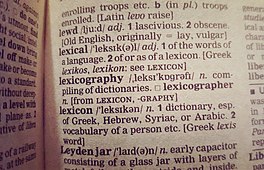Documentation:RelLex/Dëne Dédliné Yatié ʔerehtł’íscho Denínu Kuȩ́ Yatié Chipewyan Dictionary
Dëne Dédliné Yatié ʔerehtł’íscho Denínu Kuȩ́ Yatié Chipewyan Dictionary
| Relational Lexicography Knowledgebase | |
|---|---|

| |
| About RelLex | |
| An index of under-resourced North American language references, including print and digital dictionaries. | |
| Browse by | |
| About the Knowledgebase | |
| Find our filterable Knowledgebase of dictionaries and lexicography technology at https://knowledgebase.arts.ubc.ca/. | |
Language Name
Chipewyan.
Alternate Language Names
Denésoliné, Dënesųłı̨né, Dënë Sųłınë́, Dënesųłinë́ yatié, Denesuline, Dene Soline.
Region
Manitoba, Alberta, Saskatchewan, and Northwest Territories, Canada.
Who
South Slave Divisional Education Council (Publishing).
Others Involved
Brent Kaulback (Project Coordinator, Layout and Design, Photos); Betty Harnum (Linguist); Eung-Do Cook (Advisor); Lawrence Fabien (Elder and Recording Assistance); Tommy Unka, Christine Fabien, Harvey Mandeville, Denise McKay, Freddie King, Henry Calmut, Mary Jane Beaulieu (Elders Committee); Tristan Kaulback (Sound Editor); Jayne Murray, Ian Patterson, Government of Northwest Territories, Northwest Territories Archives (Photos); Yamózha Kúé Society [Dene Cultural Institute], the Official Langauges Office of the Government of the Northwest Territories (Funding); Albert Canadien, Raymond Sonfrere, Rosaline Cayen, Terri Hansen, Curtis Brown (Support).
Publishing Information
Published in 2012 by the South Slave Divisional Education Council, Fort Smith, Northwest Territories.
How People are Cited
People are cited on the publishing information page and in the Mársi Nélídi: Acknowledgements section of the dictionary.
How Information is Cited
Speakers are cited by name on the publishing information page and in the Mársi Nélídi: Acknowledgements section of the dictionary. The previous publication used is cited in the Bunídhir: Preface section.
Where is Information Coming from
Information in this dictionary primarily comes from speakers. Eung-Do Cook's A Grammar of Dëne Su̜łiné (Chipewyan) (2004) was also used in creating this dictionary.
Tools and Framework used
This dictionary is available as a physical and digital book. The physical book comes with an accompanying CD and an interactive PDF version that links to sound files for each word.
Access
Both the physical and digital books are available through the South Slave Divisional Education Council website. The digital book available on this website is open access on the Indigenous Language webpage below the Dictionaries heading. This version is non-interactive and does not include any sound files. Those interested in accessing the physical book and/or the interactive digital version (which includes sound files) are asked to contact the Public Affairs Coordinator at publishing@ssdec.org.
Included Languages and Directionality
English to Chipewyan.
Dialects Included
This dictionary contains information from the Dënedédliné yatié (t-dialect, Fort Resolution) dialect.
Type of Dictionary
This is a bilingual, mono-directional word list, followed by topical word lists.
How are Entries Organised
Entries are organized alphabetically by English in the first dictionary section. These entries include the English headword and the Chipewyan translation. Entries are organized topically in the next sections of the dictionary: Dëne Yatí Hezeldi Hunídhir: Basics, Dëne: People, Kuę́ Yízî: In the Home, Háyorįla: In the Community, Dechën Yághe: In the Bush, T'at'ú Dzékezedhi: Travel, Diri Néné K'e: The Environment, and Sa: Recreation. Each section is further subdivided by related topics. For example, the Dëne Yatí Hezeldi Hunídhir: Basics section is further topically organized into word lists about important words, commands, colours, numbers, time and seasons, calendar terms and special days, measurement and shapes, and money terms. Entries within these sections are usually organized alphabetically by English and include the English headword and the Chipewyan translation. No other information is included in any entries. The final topic, Dÿne Yatí ʔełanílye: Chipewyan Grammar, is also organized as word lists, but with more abstract concepts such as descriptive words, verbs, and making sentences, and contains grammatical information throughout, providing information about verb conjugation and sentence structure.
There is an illustrated alphabet that precedes the dictionary.
Other Features
| Feature | Included | More Information |
|---|---|---|
| Guide to use and understand | ❌ | |
| Audio | ✅ | Only with the physical and interactive digital versions (a CD and sound files, respectively) |
| Images | ✅ | Ocassional photos throughout |
| Example phrases | ❌ | As their own entries within the topically-organized sections |
| Speakers marked | ❌ | |
| Dialects marked | ❌ | There is only one dialect included; however, variations that reflect local differences in word choice or spelling are separated by a slash (/) |
External Links
The dictionary is listed on the South Slave Divisional Education Council Indigenous Language webpage below Dictionaries: https://www.ssdec.net/aboriginal-language
Direct access to the open access, non-interactive, digital dictionary through the South Slave Divisional Education Council website can be found here: https://www.ssdec.net/_files/ugd/072827_ec9a31ee98dd4832a2154aaf5c921874.pdf